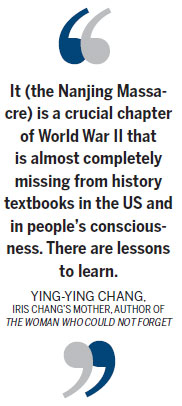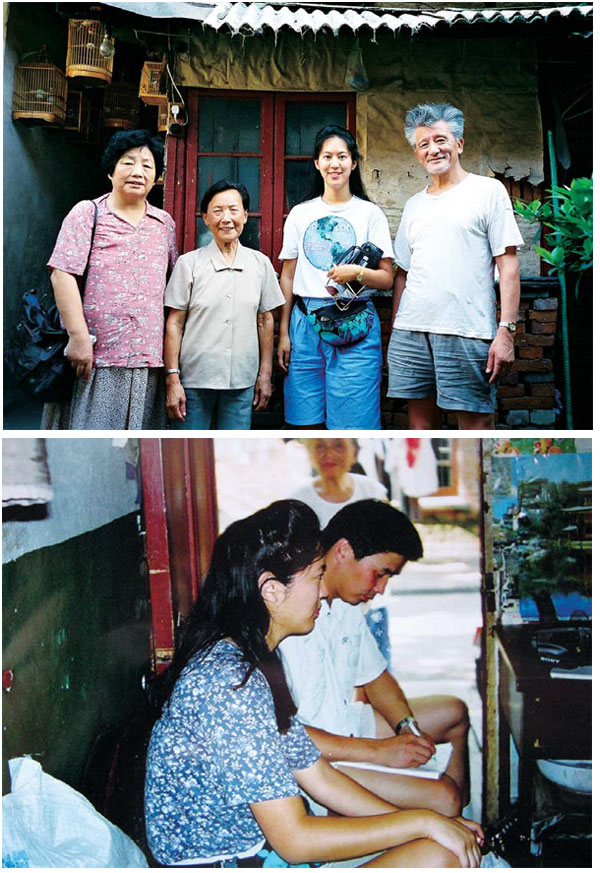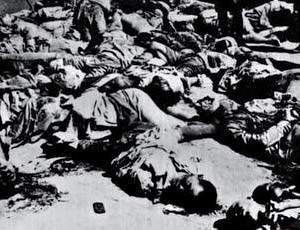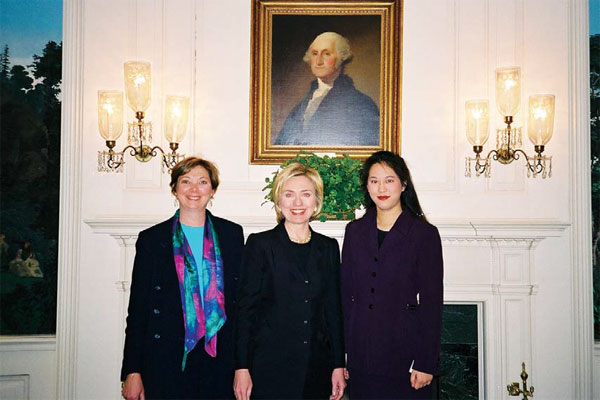The radiance and darkness of Iris Chang
Updated: 2015-12-11 08:19
By Zhao Xu(China Daily Europe)
|
|||||||||||
The rampage eventually to be known as the Nanjing Massacre not only claimed 300,000 lives but left effects that rippled down through the decades
Loneliness is a silent chirp of a cricket across a lake
Where the leaves on the trees rustle at sunset.
It smells like a violet patch.
It sounds like wind blowing through the tall prairie grass ...
|
Top: In the summer of 1995, Iris Chang (second from right) interviewed Xia Shuqin (second from left), a survivor of the Nanjing Massacre, whose arms still bore the deep bayonet cuts made by Japanese soldiers in 1937. Above: Yang Xiaming (right) did the translation for Chang when she interviewed survivors of the Nanjing Massacre in 1995. Photos Provided to China Daily |
Iris Chang wrote those lines in 1978, when she was 10, and 19 years before her harrowing history The Rape of Nanking gained her worldwide acclaim.
At the age of 27 in 1995, the author, whose name was borrowed from a Grecian goddess, flew from California to Nanjing in Jiangsu province, East China. There, under a crimson setting sun, she waded through the tall grass in an eastern suburb of the city to get to a nondescript memorial stone dedicated to those whom Japanese invaders murdered 58 years before. It was the height of summer, and all that broke the silence at dusk was the relentless chirping of crickets. The scene, and Iris' life-changing three-week sojourn in Nanjing, is described in moving detail in the book The Woman Who Could Not Forget, written by Iris' mother, Ying-Ying Chang, and published in 2011, seven years after Iris ended her life in November 2004.
In December last year, Ying-Ying Chang visited Nanjing and toured for the first time those places where her daughter had searched for a history long since buried. The 75-year-old was accompanied by Yang Xiaming, a researcher of the six-week rampage of death now known as the Nanjing Massacre. When Iris Chang had gazed at the memorial stone and the surrounding dereliction 20 years earlier, Yang had stood at her side.
"To see this young, vivacious lady, someone I had met just days before, go into a ruminating state of sadness was almost heartbreaking," says Yang, who would later act as Iris' interpreter as the Chinese-American talked to massacre survivors.
"Their tragedy was only a tiny part of the one that started on December 13, 1937, when invading Japanese troops killed an estimated 300,000 civilians and unarmed soldiers and raped countless others. But to listen to the stories of people who had crawled from under the heaps of bodies was enough to shake anyone to the core."

One such occasion involved an interview with Xia Shuqin, a massacre survivor who bore the scars of deep bayonet cuts that Japanese soldiers had inflicted on her.
"We went with the 66-year-old lady to the site of her original house, where killings took place when she was eight," Yang says. "Pointing to the dilapidated wooden lattice windows, she told us that it was through these windows that she witnessed the horrible deaths of her entire family. If you had known Iris' family history you would understand how those interviews must have resonated with her."
In March 1968, Iris Chang was born in the United States to her Chinese immigrant parents. "Iris was a curious child," Ying-Ying Chang said. "When she was around 8 or 9 she kept asking us what we were doing at her age. That's really the beginning of her story."
On July 7, 1937, the war between China and the invading Japanese officially started. In November that year China's Nationalist Government announced that it was moving its capital from Nanjing to the southwestern city of Chongqing. A mass flight ensued. Ying-Ying's father and her 7-month pregnant mother left one month before the Japanese soldiers marched into Nanjing.
For next eight years Ying-Ying's family stayed first in the city of Guiyang, then in Chongqing, where Ying-Ying Chang was born in 1940. At that time, living not far from her family, on the outskirts of the city, was
Shau-Jin Chang her future husband and Iris' father.
Born in 1937, he was 6 months old when his family arrived in Chongqing that year. Today he still remembers what happened when bombs fell.
"The Japanese bombing was virtually around the clock. Coming temporarily from the underground bomb shelter, I saw people outside with blood-splattered faces. I was around 6 at the time. However, my father told me that what happened in Chongqing was not nearly comparable to the suffering and carnage in Nanjing."
In the same way a 6-year-old Shau-Jin Chang could not conceive of the dimensions of violence in Nanjing, Iris, despite growing up listening to stories of Japanese wartime atrocities, found herself overwhelmed standing in front of poster-sized images of Nanjing war crimes, at a December 1994 conference in Cupertino, California, sponsored by the Global Alliance for Preserving the History of World War II in Asia.
"Nothing prepared me for these pictures - stark black-and-white images of decapitated heads, bellies ripped open and nude women forced by their rapist into various pornographic poses, their faces contorted into unforgettable expressions of agony and shame," Iris Chang later wrote.
By then she had graduated as a journalism student from the University of Illinois at Urbana Champaign, where both of her parents were science professors. For the next three years the budding writer was to plunge into a history that constitutes one of the darkest chapters of World War II, before emerging with a book that is "almost unbearable to read" but "should be read", to quote Ross Terrill, an Australian academic and author, and a China specialist.
The research started in the US, where, in the Yale Divinity School Library, Iris Chang read the diaries of Wilhelmina (Minnie) Vautrin, also a graduate of the University of Illinois at Urbana Champaign.
Born in 1886, the US missionary was the president of Jinling College in Nanjing when war broke out. Turning the campus into a refugee camp, she helped save tens of thousands of Chinese, mostly women, during the massacre and afterwards. Yet having witnessed so much violence, Vautrin returned to the US in early 1940 with severe stress. On May 14, 1941, she turned on a gas stove in her apartment and killed herself.
"How ashamed the women of Japan would be if they knew these tales of horror," Vautrin wrote in her diary on Dec 19, 1937.
Six months after Iris Chang read Vautrin's diary, she was in Nanjing to trace the footsteps of the courageous woman, and to find out more about the blood-chilling, heart-wrenching stories she had so frequently encountered in Vautrin's lines.
One of the interviewees was Li Xiuying, 18 years old and seven months pregnant in November 1937. After putting up a memorable fight with her assailants, Li was stabbed repeatedly and was left for dead for several hours, until a fellow Chinese noticed bubbles of blood foaming from her mouth. Friends took her to Nanjing University Hospital, where doctors stitched 37 bayonet wounds.
Unconscious, she miscarried that evening of Dec 19, the day Vautrin made her diary entry.
"Now, after 58 years, the wrinkles have covered the scars," Li told Iris Chang, pointing to her own face once crosshatched with scars so terrible that it made looking into a mirror an emotional ordeal.
But there are things that wrinkles can never cover. And during her stay in Nanjing, Iris Chang was deeply disturbed not only by the inhumanity of war, but also by what she saw as a failure to mete out appropriate justice, Yang says.
One of the survivors they visited lived in a shoebox of a space of no more than six square meters. The old man was bathing, and the water in the small basin had almost gone muddy. "The way Iris moved her video camera - from the low ceiling to the soot-covered walls and the rubbish-clotted corridors - clearly indicated her mood," Yang says.
All the information Iris Chang gathered during her stay in Nanjing, she was to "distill and filter" in the writing process, during which she was "working 70-hour weeks", says Brett Douglas, whom Iris Chang married in 1991.
And there was still research to do. After sending out more than 100 emails, Iris Chang received one reply from Ursula Reinhardt, granddaughter of John Rabe, a German businessman who, together with a handful of fellow Westerners, set up the Nanking Safety Zone in December 1937 and saved hundreds of thousands lives. For the first time, the existence of the diaries Rabe kept during the war became known to the world.
From time to time, Iris Chang would call her parents. "She talked about her nightmares and her hair loss," Ying-Ying Chang says. "I told her to stop. But she said no. She said she wanted to speak for those who could no longer do so."
The Rape of Nanking was published in December 1997. "We expected it to sell 10,000 to 20,000 copies," Douglas said. "It sold close to 500,000 in the United States alone. The book remained on top of the New York Times' bestseller list for 10 weeks and was translated into Chinese the following year.

With the accolades for her work came attacks, and Iris Chang was forced to defend the veracity of her account.
"She was fierce and fearless," Ying-Ying Chang says, referring to her daughter's appearance in a television debate with the then Japanese ambassador to the US Kunihiko Saito, in 1998. After the ambassador talked about events in Nanjing, Iris Chang turned to the presenter and said, "I didn't hear an apology."
On a personal level, the book continued to exert influence on Iris Chang's life, long after she started working on other projects, Douglas says.
"For the last seven years of her life, people were contacting her with their own horror stories to tell about the Japanese military, and people were approaching her trying to persuade her to write more books on the subject."
Then, in late 2003, Iris Chang began research for a possible new book on the Bataan Death March, undertaken by surrendered US and Filipino soldiers at the hands of their Japanese capturers, through the sweltering jungle on Bataan Peninsula in the Philippines.
In August 2004, Iris Chang flew to Louisville, Kentucky, to meet a Bataan veteran. Soon after arriving, she collapsed in a hotel room but later managed to have herself admitted into a psychiatric hospital. The doctor diagnosed "brief reactive psychosis".
"The Iris Chang I first met in October 1988 never came back," Douglas said.
After struggling with her condition for months, Iris killed herself with a revolver on Nov 9, 2004. Messages of condolence flooded in, but her death also provided an opening for her detractors, who alleged that she had written The Rape of Nanking under delusion.
This is an assertion that Iris Chang's husband of 13 years flatly rejects. "Iris completed The Rape of Nanking in early 1997 but never showed any real signs of mental illness until 2004," says Douglas, who also sees no direct connection between Chang's death and the horror she endured writing the book.
"Rather than upsetting her, seeing the photos and reading the materials energized her and drove her to do the best job she could to tell the stories."
Ying-Ying Chang, a microbiology professor, strongly suspected that antidepressants Iris Chang was taking at the time of her death had increased suicidal tendencies she already harbored.
In September 2005, one year after Iris Chang died, Ying-Ying and Shau-Jin Chang were invited to Nanjing for the unveiling of a bronze statue of their daughter at the city's Memorial Hall for the Victims of the Nanjing Massacre.
"I left China in 1949 with my parents when I was 9 and had never been back to Nanjing until 2005," Ying-Ying Chang says.
|
Victims of the Nanjing Massacre in 1937. |
"We told our history to Iris, who then, through her work and her book, brought us back to where we had come from."
Since then the couple, who have set up the Iris Chang Memorial Fund in the US, have been to China seven times.
"We sponsored US high-school teachers to travel here and learn about the Nanjing Massacre," Ying-Ying Chang says. "It's a crucial chapter of World War II that is almost completely missing from history textbooks in the US and in people's consciousness. There are lessons to learn."
Those lessons are likely to come sharply into focus for many on Dec 13, when national memorial day for the Nanjing Massacre is marked.
Toward the end of her book, Iris Chang wrote: "Japan's behavior during World War II was less a product of dangerous people than of a dangerous government, in a vulnerable culture, in dangerous times, able to sell dangerous rationalizations to those whose human instincts told them otherwise."
Each time Iris Chang's parents were in Nanjing, Yang accompanied them.
"For a very long time in China, discussion of the Nanjing Massacre was not particularly encouraged, partly because of the shame involved," the 57-year-old Yang said. "Today, another type of shame, one that Iris had instilled in me, propels me forward in my research of the massacre."
Yang, who in 2007 did his own translation of Iris Chang's book from English to Chinese, said he could not wipe from his mind the sight of Chang, standing before the memorial stone in suburban Nanjing. The setting sun gilt-rimmed the stele and illuminated her young face.
For those who were in touch with her young genius, that scene may call to mind another poem Iris Chang wrote, when she was the editor of her high-school literary magazine. The poem is titled Sunrise.
Rosy luminance appears
Over the edge of the earth
Banishing all the darkness
To reveal a new day's birth ...
zhaoxu@chinadaily.com.cn
|
As author of the Rape of Nanking, Iris Chang was invited to the White House to meet Hillary Clinton in 1999. Provided to China Daily |
|
Ying-Ying Chang (center) and Shau-Jin Chang (left) attend a memorial service on Dec 13, 2014. The Chinese government has designated Dec 13 as the memorial day for the Nanjing Massacre. |
(China Daily European Weekly 12/11/2015 page24)
Today's Top News
Putin, Cameron discuss Syria crisis, anti-terror fight
11 children drown at sea
Unregistered citizens to finally gain recognition
Aging population could shrink workforce by 10%
China seeks advice of foreign experts on economic blueprint
Aging population could shrink workforce by 10% in China
Czech president warns of terrorist attack
EU members agree on bloc's first cyber-security law
Hot Topics
Lunar probe , China growth forecasts, Emission rules get tougher, China seen through 'colored lens', International board,
Editor's Picks

|

|

|

|

|

|










